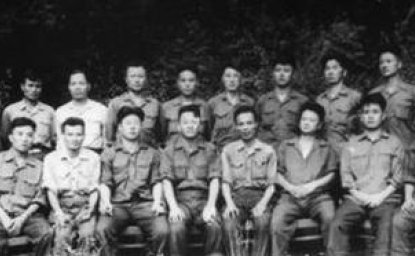Vietnam Covertly Supplied Weapons to Revolutionaries in Algeria and Latin America

CWIHP e-Dossier No. 25
Reports that the Vietnamese communist regime in Hanoi was providing weapons, ammunition, and other support to leftist insurgencies around the world have circulated for many years, but while the Vietnamese government and the Vietnamese Communist Party openly provided verbal support to such insurgencies in Asia, Africa, the Middle East, and Latin America, the Vietnamese have never admitted to actually providing weapons and equipment to these revolutionary movements. During the 1980s the U.S. Government accused Vietnam of supplying U.S.-made M-16 rifles that Vietnam had captured when South Vietnam fell in 1975 to the leftist insurgents fighting to overthrow the pro-American government of El Salvador. In 1986 General Pinochet’s Chilean government announced that it had captured large caches of weapons and ammunition, including 3,000 M-16 rifles that had been originally shipped to the South Vietnamese Army, and accused the Vietnamese of supplying these weapons to the Chilean insurgents. While the serial numbers of many of the M-16s captured from El Salvadoran insurgents could be traced back to pre-1975 U.S. weapons shipments to the South Vietnamese army, there was never any definitive proof that it was the communist government of Vietnam, and not unscrupulous private individuals or arms dealers, that had provided the weapons to the El Salvadoran guerrillas and other Latin American insurgents.[1]
In 2008 a Vietnamese website devoted to serving Vietnamese army veterans posted excerpts from an official internal Vietnamese army history that provides documentary evidence that the Vietnamese armed forces had in fact shipped captured American-made weapons to Latin American insurgents, apparently through the Cubans, during the late 1970s and early 1980s. The documents also reveal that in 1958 the Vietnamese, in apparent cooperation with Poland and the Soviet Union, covertly provided a large quantity of captured French submachine guns to Algerian rebels fighting for independence against French colonial rule.
Note: This particular Vietnamese army history and all of the other such official histories were purged from the website in 2009, apparently after Vietnamese government security censors realized that sensitive internal documents had been posted on this website. The original Vietnamese-language documents presented below, along with English translations, were downloaded from the Vietnamese website before the website was purged.
Document 1
Excerpt from Ordnance: Chronology of Historical Events, Volume 1 (Biên niên sự kiện lịch sử quân khí, Tập 1), Hanoi: People's Army Publishing House, 1996. Translated for CWIHP by Merle Pribbenow.
23 June 1958
Implementing instructions received from the General Military Party Committee[2] and the Ministry of Defense, the Ordnance Department arranged for a large quantity of Tulle submachine guns (weapons captured by our forces during the resistance war against the French)[3] to be wrapped and packaged so that they could be provided to the Algerian people to help them in their resistance war against the French colonialists.
This was a special, top-secret program, so the Ordnance Department arranged for it to be carried out in a very careful and secure manner. A technical team was selected to carry out this mission. This team was headed by Comrade Nguyen Quang Thanh and included Phung Thanh Toan, Ha Vien, etc.
The preservation, standardization, and wrapping of the guns was done in Warehouse 560 at Bach Mai, after which the guns were secretly transported to a staging location at Kha Lam Warehouse in Kien An to be held there for loading aboard a Polish ship that would transport them to our [Algerian] friends under the guise of commercial goods.
This plan was carried out under the guidance and close supervision of the Party Secretariat, the General Military Party Committee, and the Ministry of Defense. This operation began on 23 June and was completed on 24 July 1958, and complete safety and secrecy was maintained throughout the implementation of the plan.
Document 2
1976-1982 excerpts from "Ordnance: Chronology of Historical Events, Volume 2"(Biên niên sự kiện lịch sử quân khí, Tập 2), Hanoi: People's Army Publishing House, 1999. Translated for CWIHP by Merle Pribbenow.
Editorial Supervision: Ordnance Department Party Current Affairs Committee and Department Command
Author: Colonel Nguyen Quoc Trong [Nguyễn Quốc Trọng]
People’s Army Publishing House, Hanoi, 1999
1976
[…]
9 December 1976Implementing Plan for Packaging “X” Supplies
Pursuant to orders received from the General Staff and the General Political Department, the Department for the Handling of Weapons, Equipment, and Ammunition [Cục Quản Lý Vũ Khí, Khí Tài, Đạn Dược] packaged up a quantity of ammunition to support our international responsibilities (Plan X). These supplies were carefully preserved and packaged securely to ensure secrecy.
A number of the department’s ammunition storage warehouses carried out Plan X quickly and correctly, meeting the goals set by higher authority.
[…]
1980
[…]
5 February 1980Implementing Plan “N” and Plan “C”[4]
Pursuant to directions received from the General Staff and the General Political Department, on 5 February 1980 the Chief of the Department for the Handling of Weapons, Equipment, and Ammunition issued instructions for General Warehouse 767 to inspect, carry out technical preparations, and standardize a large quantity of second-generation ordnance equipment to be used to carry out our responsibility to provide international aid (Plans “N” and “C”).
Displaying a pure, noble spirit of international solidarity, General Warehouse 767 carried out the plan quickly and correctly, ensuring that the materials supplied were of the highest quality, that they were standardized [uniform], and that there were sufficient manuals and guidance documents written in the foreign language.
The turnover of all of this second-generation ordnance equipment to representatives of the friendly [allied] country was completed by 14 February 1980.
[...]
9 August 1980Implementing Plan “S”[5]
Pursuant to a decision of the General Staff, the commander of the Department for the Handling of Weapons, Equipment, and Ammunition ordered the department’s headquarters element stationed in South Vietnam to implement “Plan S” at the request of our friends [allies]. The department requested that the various types of second-generation ordnance equipment[6] listed in this plan be inspected for quality and uniformity and then packaged up for shipment.
In early August 1980, Comrade Nguyen Ngoc Luong [Nguyễn Ngọc Lương], Deputy Department Chief, acting as the representative for the Vietnamese side, officially turned over this ordnance equipment to a responsible friendly [allied] officer in Vietnam.
[...]
12 October 1980Military Attaché of the Cuban Embassy in Vietnam Visits General Warehouse 767
With the permission of the Ministry of Defense and the commanders of the General Technical Department and of the Department for the Handling of Weapons, Equipment, and Ammunition, on 12 October 1980 the Cuban Military Attaché from the Cuban Embassy in Vietnam visited General Warehouse 767 to mark the General Warehouse’s successful completion of Plans “N,” “C,” and “S.”
After visiting the unit’s headquarters compound at the General Warehouse’s headquarters office the military attaché gave a gift to the General Warehouse as a souvenir and wrote the following lines in the unit’s tradition book: “This is a great honor for me. This visit to your unit is of special significance because all of the officers and enlisted men of the General Warehouse have completed a task that, although relatively simple, is of tremendous significance for the success of the Asian and Latin American revolutions and for all peoples who have or are prepared to fight for their own permanent liberation.”
[...]
1982
[…]
2 July 1982Completion of the International Aid Plans
On 27 February 1980, the General Staff issued Decision No. 332/QDTM regarding the Ammunition Department’s preparation of a number of types of second-generation ordnance equipment to provide as international aid. This plan was called “KH-3,” codename “LEMUS.” Following the completion of this plan, the Ammunition Department completed four more plans pursuant to decisions issued by the General Staff.
The Ammunition Department gave its warehouses in South Vietnam the responsibility of carrying out these plans from early 1980 through the end of June 1982. The Ammunition Department delivered the equipment to our friends [allies] at the port of Saigon. All of the equipment and supplies covered by these five plans were transported on two ships, one of which sailed on 26 June 1982 and the other on 2 July 1982. The quantity, quality, and other factors of these supplies and equipment met all of the General Staff’s requirements and specifications.
[…]
Merle L. Pribbenow, a native of the Pacific Northwest, graduated from the University of Washington in 1968 with a bachelor's degree in political science. After serving in the CIA for 27 years, he retired in 1995 and is now an independent researcher/author specializing in the Vietnam War.
Footnotes
[1] See Michael Klare and David Andersen, A Scourge of Guns: The Diffusion of Small Arms and Light Weapons in Latin America, The Federation of American Scientists (FAS), Washington D.C., 1996, pages 83-84; “Salvador Rebels: Where Do They Get The Arms?”, New York Times, 24 November 1988; Jose Angel Moroni Bracamonte and David E. Spencer, Strategy and Tactics of the Salvadoran FMLN Guerrillas, Praeger, Westport CT, 1995, page 179.
[2] The General Military Party Committee (Tổng quân ủy) was a committee made up of a small number of members of the Communist Party Politburo that was responsible for supervising and directing the Vietnamese armed forces. This committee was headed by General Vo Nguyen Giap.
[3] The “Tulle” submachine gun referred to is the MAT-49, a French 9mm submachine gun that was used by the French Army during the war in Indochina. The Vietnamese captured large quantities of these weapons during the war, especially at the battle of Dien Bien Phu. The term “Tulle” comes from the name of the French manufacturer: Manufacture Nationale d’Armes de Tulle (MAT).
[4] Plan “N” may refer to Nicaragua, meaning the weapons were intended for delivery to the Sandanistas in Nicaragua. Plan “C” may refer to Chile or to Cuba, meaning that the weapons were to be delivered to Marxist guerrillas in Chile or directly to Cuba.
[5] Plan “S” may refer to Salvador, meaning that the weapons were to be delivered to the FMLN guerrillas in El Salvador.
[6] The Vietnamese use the term “second generation” to refer to captured U.S-made equipment and weapons. Soviet and Chinese-made weapons and equipment supplied to North Vietnam during the Vietnam War are referred to as “first generation” material.
Author

Cold War International History Project
The Cold War International History Project supports the full and prompt release of historical materials by governments on all sides of the Cold War. Read more

Explore More
Browse Insights & Analysis
North Korean Pilots in the Skies over Vietnam


